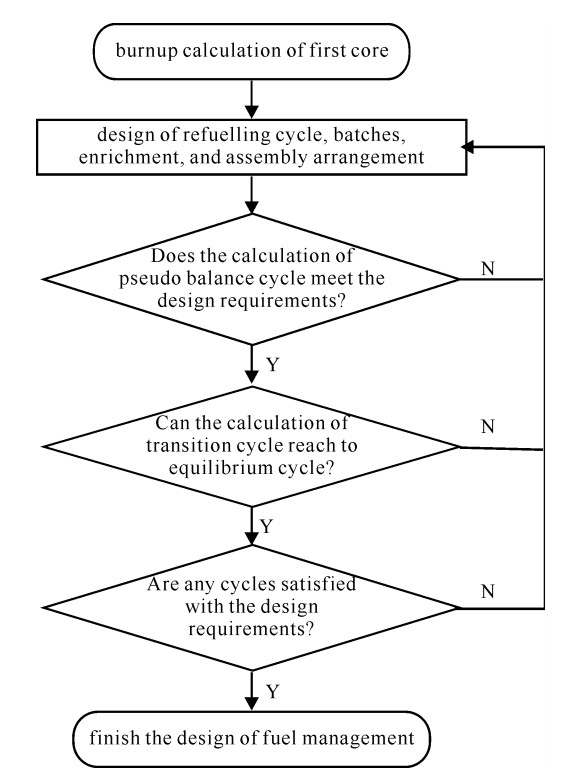In-core fuel management strategy design of lead-cooled fast reactor M2LFR-1000
-
摘要: 堆芯燃料管理是反应堆设计中极为重要而且复杂的工作,直接影响着堆芯的经济性。目前国内外对于压水堆等传统热堆已有了较为丰富和成熟的燃料管理计算方法,但对于快堆,由于其中子能谱硬,与传统热堆相比有着不同的控制方式和功率分布,快堆的堆芯燃料管理缺乏系统研究。针对中国科学技术大学自主研发的强迫循环冷却的铅基快堆M2LFR-1000,应用SRAC/COREBN软件包进行堆芯燃耗计算,根据燃耗深度提取核素核子密度,计算伪平衡循环参数进行燃料管理预估,然后进行首循环装料、过渡循环和平衡循环燃料管理方案设计。结果表明:对M2LFR-1000堆芯外区燃料换料组件Pu的富集度进行优化,可以延长换料周期到540 d,提高平均卸料燃耗深度;伪平衡循环结果与平衡循环基本一致,伪平衡循环可以用于燃料管理预估。Abstract: Fuel management is an extremely important and complex work in reactor design and directly affects the economics of the reactor. Now, there are many mature fuel management calculation methods for PWR and other traditional thermal reactors around the world. However, because of their hard neutron spectra, control modes and power distributions of fast reactors are different from those of traditional thermal reactors. There is a lack of systematic study of fuel management for fast reactors. Based on the SRAC/COREBN software package which provides the atom density of the nuclides at different burnup levels, a pseudo-equilibrium cycle parameter was calculated for the fuel management pre-estimation of forced circulation lead cooled fast reactor M2LFR-1000 independently developed by University of Science and Technology of China. Then, refueling schemes of the initial, transition and equilibrium cycles were designed. The results show that optimizing the Pu enrichment of outer fuel assemblies in M2LFR-1000 core can extend the cycle length to 540 d and increase the average discharge burnup. The pseudo-equilibrium cycle results are basically the same as those of the equilibrium cycle. The pseudo-equilibrium cycle can be used for fuel management pre-estimation.
-
Key words:
- lead-cooled fast reactor /
- fuel management /
- pseudo-equilibrium cycle /
- equilibrium cycle
-
表 1 M2LFR-1000换料设计要求
Table 1. Main requirements of M2LFR-1000 for reloading
core parameter design requirement cycle length as long as possible assembly power peaking factor <1.30 fuel Doppler coefficient <0 shutdown margin ≥2900 pcm assembly burnup <100 GWd/tHM 表 2 内外分区三批换料伪平衡循环计算结果
Table 2. Pseudo-equilibrium cycle result for three batches reloading
parameters value unit cycle length 450 d BOC maximum linear power density 117.8 W/cm MOC maximum linear power density 118.9 W/cm EOC maximum linear power density 118.3 W/cm BOC maximum neutron flux 2.15 1015 n/(cm2·s) MOC maximum neutron flux 2.17 1015 n/(cm2·s) EOC maximum neutron flux 2.13 1015 n/(cm2·s) BOC assembly power peaking factor 1.21 MOC assembly power peaking factor 1.20 EOC assembly power peaking factor 1.20 BOC fuel Doppler coefficient -1.05 pcm/K MOC fuel Doppler coefficient -1.06 pcm/K EOC fuel Doppler coefficient -1.05 pcm/K BOC coolant temperature coefficient -0.13 pcm/K MOC coolant temperature coefficient -0.20 pcm/K EOC coolant temperature coefficient -0.16 pcm/K BOC axial expansion coefficient -102.2 pcm/% MOC axial expansion coefficient -104.7 pcm/% EOC axial expansion coefficient -108.5 pcm/% BOC radial expansion coefficient -485.2 pcm/% MOC radial expansion coefficient -494.6 pcm/% EOC radial expansion coefficient -496.7 pcm/% BOC effective delay neutron fraction 341 pcm MOC effective delay neutron fraction 349 pcm EOC effective delay neutron fraction 354 pcm BOC prompt neutron lifetime 886 ns MOC prompt neutron lifetime 862 ns EOC prompt neutron lifetime 855 ns shutdown margin 5696 pcm inner maximum discharge assembly burnup 48.60 GWd/tHM outer maximum discharge assembly burnup 49.82 GWd/tHM inner average discharge assembly burnup 47.47 GWd/tHM outer average discharge assembly burnup 41.38 GWd/tHM 表 3 延长换料周期伪平衡循环计算结果
Table 3. Pseudo-equilibrium cycle result for extending the refueling cycle
parameters value unit cycle length 540 d BOC maximum linear power density 122.9 W/cm MOC maximum linear power density 121.4 W/cm BOC maximum neutron flux 2.20 1015 n/(cm2·s) MOC maximum neutron flux 2.22 1015 n/(cm2·s) EOC maximum neutron flux 2.15 1015 n/(cm2·s) BOC assembly power peaking factor 1.23 MOC assembly power peaking factor 1.22 EOC assembly power peaking factor 1.21 BOC fuel Doppler coefficient -1.03 pcm/K MOC fuel Doppler coefficient -1.02 pcm/K EOC fuel Doppler coefficient -1.09 pcm/K BOC coolant temperature coefficient -0.20 pcm/K MOC coolant temperature coefficient -0.15 pcm/K EOC coolant temperature coefficient -0.16 pcm/K BOC axial expansion coefficient -95.1 pcm/% MOC axial expansion coefficient -112.2 pcm/% EOC axial expansion coefficient -120.2 pcm/% BOC radial expansion coefficient -371.3 pcm/% MOC radial expansion coefficient -398.4 pcm/% EOC radial expansion coefficient -409.6 pcm/% BOC effective delay neutron fraction 360 pcm MOC effective delay neutron fraction 383 pcm EOC effective delay neutron fraction 371 pcm BOC prompt neutron lifetime 928 ns MOC prompt neutron lifetime 839 ns EOC prompt neutron lifetime 835 ns shutdown margin 5325 pcm inner maximum discharge assembly burnup 56.75 GWd/tHM outer maximum discharge assembly burnup 62.35 GWd/tHM inner average discharge assembly burnup 55.14 GWd/tHM outer average discharge assembly burnup 51.18 GWd/tHM 表 4 初始及过渡循环计算结果
Table 4. Core results of initial and transition cycle for 540 d reloading
parameter cycle 1 cycle 2 cycle 3 cycle 4 cycle 5 cycle 6 cycle length/d 660 510 510 540 540 540 BOC maximum linear power density/(W·cm-1) 132.8 117.4 119.4 123.4 123.8 126.3 MOC maximum linear power density/(W·cm-1) 122.1 127.4 122.6 122.6 122.6 129.8 EOC maximum linear power density/(W·cm-1) 146.1 117.5 121.7 113.9 120.8 114.4 BOC maximum neutron flux/[1015 n/(cm2·s)] 2.33 2.12 2.17 2.22 2.21 2.26 MOC maximum neutron flux/[1015 n/(cm2·s)] 2.19 2.28 2.25 2.25 2.25 2.35 EOC maximum neutron flux/[1015 n/(cm2·s)] 3.06 2.15 2.25 2.08 2.20 2.09 BOC assembly power peaking factor 1.29 1.23 1.21 1.25 1.24 1.23 MOC assembly power peaking factor 1.25 1.26 1.19 1.19 1.19 1.28 EOC assembly power peaking factor 1.26 1.20 1.19 1.22 1.20 1.21 BOC fuel Doppler coefficient/(pcm/K) -1.10 -1.08 -1.05 -1.03 -1.04 -1.05 MOC fuel Doppler coefficient/(pcm/K) -1.04 -1.07 -0.98 -0.98 -0.98 -1.01 EOC fuel Doppler coefficient/(pcm/K) -1.06 -1.04 -1.00 -1.01 -1.01 -0.99 BOC coolant temperature coefficient/(pcm/K) -0.18 -0.15 -0.17 -0.16 -0.20 -0.16 MOC coolant temperature coefficient/(pcm/K) -0.14 -0.19 -0.11 -0.11 -0.11 -0.14 EOC coolant temperature coefficient/(pcm/K) -0.17 -0.17 -0.16 -0.16 -0.16 -0.15 BOC axial expansion coefficient/(pcm/%) -95.1 -103.2 -101.3 -96.7 -94.6 -88.5 MOC axial expansion coefficient/(pcm/%) -97.2 -107.3 -109.2 -99.4 -99.2 -94.3 EOC axial expansion coefficient/(pcm/%) -89.6 -115.8 -112.5 -103.9 -89.4 -92.1 BOC radial expansion coefficient/(pcm/%) -402.6 -452.7 -449.7 -409.6 -401.2 -394.8 MOC radial expansion coefficient/(pcm/%) -408.3 -459.4 -461.3 -415.2 -412.9 -406.3 EOC radial expansion coefficient/(pcm/%) -396.2 -466.3 -464.8 -424.1 -396.1 -402.7 BOC effective delay neutron fraction/pcm 328 333 352 369 364/ 335 MOC effective delay neutron fraction/pcm 369 339 342 342 342 358 EOC effective delay neutron fraction/pcm 342 329 326 341 318 317 BOC prompt neutron lifetime/ns 888 909 841 885 906 845 MOC prompt neutron lifetime/ns 861 927 907 907 907 859 EOC prompt neutron lifetime/ns 899 858 863 820 843 835 shutdown margin/pcm 5202 5419 5394 5215 5195 5180 inner maximum discharge assembly burnup/(GWd/tHM) 22.76 41.35 59.42 54.59 55.59 56.64 outer maximum discharge assemblyburnup/(GWd/tHM) 26.91 45.42 61.83 59.70 60.79 61.53 inner average discharge assemblyburnup/(GWd/tHM) 21.88 40.04 57.80 53.01 53.86 54.90 outer average discharge assemblyburnup/(GWd/tHM) 25.06 39.14 51.17 49.79 50.84 51.47 表 5 540 d换料平衡循环计算结果
Table 5. Core results of equilibrium cycle for 540 d reloading
parameter value unit cycle length 540 d BOC maximum linear power density 126.3 W/cm MOC maximum linear power density 129.8 W/cm EOC maximum linear power density 114.4 W/cm BOC maximum neutron flux 2.26 1015 n/(cm2·s) MOC maximum neutron flux 2.35 1015 n/(cm2·s) EOC maximum neutron flux 2.09 1015 n/(cm2·s) BOC assembly power peaking factor 1.23 MOC assembly power peaking factor 1.28 EOC assembly power peaking factor 1.21 BOC fuel Doppler coefficient -1.05 pcm/K MOC fuel Doppler coefficient -1.01 pcm/K EOC fuel Doppler coefficient -0.99 pcm/K BOC coolant temperature coefficient -0.16 pcm/K MOC coolant temperature coefficient -0.14 pcm/K EOC coolant temperature coefficient -0.15 pcm/K BOC axial expansion coefficient -88.5 pcm/% MOC axial expansion coefficient -94.3 pcm/% EOC axial expansion coefficient -92.1 pcm/% BOC radial expansion coefficient -394.8 pcm/% MOC radial expansion coefficient -406.3 pcm/% EOC radial expansion coefficient -402.7 pcm/% BOC effective delay neutron fraction 335 pcm MOC effective delay neutron fraction 358 pcm EOC effective delay neutron fraction 317 pcm BOC prompt neutron lifetime 845 ns MOC prompt neutron lifetime 859 ns EOC prompt neutron lifetime 835 ns shutdown margin 5180 pcm inner maximum discharge assembly burnup 56.64 GWd/tHM outer maximum discharge assembly burnup 61.53 GWd/tHM inner average discharge assembly burnup 54.90 GWd/tHM outer average discharge assembly burnup 51.47 GWd/tHM -
[1] Alemberti A, Carlsson J, Malambu E, et al. European lead fast reactor-ELSY[J]. Nuclear Engineering & Design, 2011, 241(9): 3470-3480. [2] 肖宏才. 自然安全的BREST铅冷快堆——现代核能体系中最具发展潜力的堆型[J]. 核科学与工程, 2015, 35(3): 395-406. https://www.cnki.com.cn/Article/CJFDTOTAL-HKXY201503001.htmXiao Hongcai. Lead-cooled natural safe fast reactor BREST—The most potential reactor in the modern nuclear power system. Nuclear Science and Engineering, 2015, 35(3): 395-406 https://www.cnki.com.cn/Article/CJFDTOTAL-HKXY201503001.htm [3] Chen H, Chen Z, Chen C, et al. Conceptual design of a small modular natural circulation lead cooled fast reactor SNCLFR-100[J]. International Journal of Hydrogen Energy, 2016, 41(17): 7158-7168. doi: 10.1016/j.ijhydene.2016.01.101 [4] Chen H, Zhang X, Zhao Y, et al. A medium-power modular lead-cooled fast reactor M2LFR-1000 emphasizing application of optimization methods in preliminary design[C]//The 8th Korea-China Workshop on Nuclear Reactor Thermal-Hydraulics (WORTH-8). 2017. [5] 李友谊, 杨晓强, 姚进国, 等. 田湾核电站18个月换料燃料管理策略[J]. 原子能科学技术, 2014, 48(11): 2072-2077. doi: 10.7538/yzk.2014.48.11.2072Li Youyi, Yang Xiaoqiang, Yao Jinguo, et al. Fuel management scheme on 18 months refueling for Tianwan nuclear power station. Atomic Energy Science and Technology, 2014, 48(11): 2072-2077 doi: 10.7538/yzk.2014.48.11.2072 [6] 姚红. 157组燃料组件组成的堆芯燃料管理研究[J]. 原子能科学技术, 2013, 47(10): 1845-1851. doi: 10.7538/yzk.2013.47.10.1845Yao Hong. Fuel management study on PWR core included of 157 fuel assemblies. Atomic Energy Science and Technology, 2013, 47(10): 1845-1851 doi: 10.7538/yzk.2013.47.10.1845 [7] 刘国明, 郭治鹏. HPR1000堆芯装载50%MOX组件的燃料管理方案[J]. 强激光与粒子束, 2017, 29: 036010. doi: 10.11884/HPLPB201729.160376Liu Guoming, Guo Zhipeng. Fuel loading pattern with 50% MOX fuel in HPR1000 core. High Power Laser and Particle Beams, 2017, 29: 036010 doi: 10.11884/HPLPB201729.160376 [8] 赵晶, 刘志宏, 郭德朋, 等. 大功率压水堆堆芯燃料管理设计[J]. 原子能科学技术, 2012, 46(s1): 397-402. https://www.cnki.com.cn/Article/CJFDTOTAL-YZJS2012S1084.htmZhao Jing, Liu Zhihong, Guo Depeng, et al. In-core fuel management design of large power PWR. Atomic Energy Science and Technology, 2012, 46(s1): 397-402 https://www.cnki.com.cn/Article/CJFDTOTAL-YZJS2012S1084.htm [9] Castillo A, Ortiz J J, Montes J L, et al. Fuel loading and control rod patterns optimization in a BWR using Tabu search[J]. Annals of Nuclear Energy, 2007, 34(3): 207-212. [10] Ortiz J J, Requena I. Using a multi-state recurrent neural network to optimize loading patterns in BWRs[J]. Annals of Nuclear Energy, 2004, 31(7): 789-803. doi: 10.1016/j.anucene.2003.11.001 [11] Grasso G, Petrovich C, Mattioli D, et al. The core design of ALFRED, a demonstrator for the European lead-cooled reactors[J]. Nuclear Engineering & Design, 2014, 278(278): 287-301. [12] Petrovich C, Grasso C, Rocchi F. D07-definition of the ETDR core and neutronic characterization—Part Ⅰ[R]. Italy: Centro Ricerche Bologna, 2013. [13] Petrovich C. ALFRED core. Summary, synoptic tables, conclusions and recommendations[R]. Italy: Centro Ricerche Bologna, 2013. [14] 杨晓燕. 快堆堆芯燃料管理优化研究[D]. 北京: 清华大学, 2010.Yang Xiaoyan. Research on optimization of in-core fuel management of fast reactor. Beijing: Tsinghua University, 2010 [15] Okumura K, Kugo T, Kaneko K, et al. SRAC2006: a comprehensive neutronics calculation code system[R]. Japan Atomic Energy Agency, 2007. [16] Okumura K. COREBN: A core burn-up calculation module for SRAC2006[R]. Japan Atomic Energy Agency, 2007. [17] X-5 Monte Carlo Team. MCNP-A general Monte Carlo N-particle transport code[R]. Los Alamos National Laboratory, 2003. [18] 吕征, 沈峰, 孙志勇, 等. SRAC程序在中国先进研究堆上的应用研究[J]. 原子能科学技术, 2009, 43(s2): 407-411. https://www.cnki.com.cn/Article/CJFDTOTAL-YZJS2009S2054.htmLü Zheng, Shen Feng, Sun Zhiyong, et al. Application of SRAC system on china advanced research reactor. Atomic Energy Science and Technology, 2009, 43(s2): 407-411 https://www.cnki.com.cn/Article/CJFDTOTAL-YZJS2009S2054.htm -





 下载:
下载:





